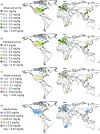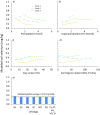Selenium deficiency risk predicted to increase under future climate change
- PMID: 28223487
- PMCID: PMC5358348
- DOI: 10.1073/pnas.1611576114
Selenium deficiency risk predicted to increase under future climate change
Abstract
Deficiencies of micronutrients, including essential trace elements, affect up to 3 billion people worldwide. The dietary availability of trace elements is determined largely by their soil concentrations. Until now, the mechanisms governing soil concentrations have been evaluated in small-scale studies, which identify soil physicochemical properties as governing variables. However, global concentrations of trace elements and the factors controlling their distributions are virtually unknown. We used 33,241 soil data points to model recent (1980-1999) global distributions of Selenium (Se), an essential trace element that is required for humans. Worldwide, up to one in seven people have been estimated to have low dietary Se intake. Contrary to small-scale studies, soil Se concentrations were dominated by climate-soil interactions. Using moderate climate-change scenarios for 2080-2099, we predicted that changes in climate and soil organic carbon content will lead to overall decreased soil Se concentrations, particularly in agricultural areas; these decreases could increase the prevalence of Se deficiency. The importance of climate-soil interactions to Se distributions suggests that other trace elements with similar retention mechanisms will be similarly affected by climate change.
Keywords: climate change; global distribution; prediction; selenium; soils.
Conflict of interest statement
The authors declare no conflict of interest.
Figures











References
-
- Stoltzfus RJ, Mullany L, Black RE. In: Iron Deficiency Anaemia. Comparative Quantification of Health Risks: Global and Regional Burden of Disease Attribution to Selected Major Risk Factors. Ezzati M, Lopez AD, Rodgers A, Murray CJL, editors. Vol 1. World Health Organization; Geneva: 2004. pp. 163–210.
-
- Adamson P. Vitamin and Mineral Deficiency: A Global Progress Report. Micronutrient Initiative; UNICEF, Ottawa: 2004.
-
- Fordyce FM. Selenium deficiency and toxicity in the environment. In: Selinus O, et al., editors. Essentials of Medical Geology. Springer; London: 2013. pp. 373–415.
-
- James L, et al. Selenium Poisoning in Livestock: A Review and Progress. Selenium in Agriculture and the Environment. Soil Science Society of America and American Society of Agronomy; Madison, WI: 1989. pp. 123–131.
Publication types
MeSH terms
Substances
Grants and funding
LinkOut - more resources
Full Text Sources
Other Literature Sources

